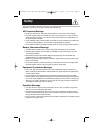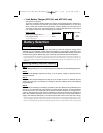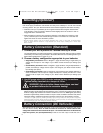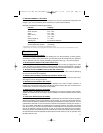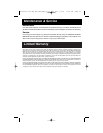
6
• Load Sharing
(DIP Switches #1, Group B & #2, Group B)
Your APS features a high-output battery charger that can draw a significant amount of power
from your line power source when charging at its maximum rate. If an APS is supplying its full
AC power rating to its connected load at the same time as it is charging, it could trip its line
source circuit breaker.Tripping this breaker will cut off AC power to your load and stop battery
charging.
To reduce the chance of tripping this breaker, select APS models may be set to automatically
limit their charger output to keep the sum of their AC load and charger power within their
circuit breakers’ rating.
This charger limiting function has four settings, allowing you to choose less charger limiting for
APS configurations with higher rated breakers. The figures below show how to set your DIP
Switches to select how heavy a load can be placed on your APS before charger limiting begins.
• Equalize Battery Charge
(DIP Switch #3, Group B)
This DIP Switch is momentarily engaged to begin the process of equalizing the internal resistance
of your battery's cells.This can extend the useful life of certain types of batteries; consult with
your battery's manufacturer to determine if your batteries could benefit from this process.The
charge equalization process is automatic and once started can only be stopped by removing
the input power.
SETTING PROCEDURE:
1) Move to “Equalize” (DOWN) position for three seconds.
2) Move to “Reset” (UP) position and leave it there.
CAUTION: Battery charge equalization should only be performed in strict accordance
with the battery manufacturer's instructions and specifications.
CAUTION: Do not leave DIP switch #3 in the down position after beginning process.
Battery Charge Switch Position
Reset ............................................................Up*
Equalize ......................................................Down
* Factory default setting.
• Disable Battery Charger (APS 2448 only)
(DIP Switch #4, Group B)
If you are connecting the APS 2448 to batteries with a separate charger, you may disable
the APS 2448’s built-in charger with this switch to prevent overcharging.
Batter
y Charger Switch Position
Disable..........................................................Up*
Enable ..........................................................Down
* Factory default setting.
Reset*
Equalize
Disable*
Enable
Battery Charger Limiting Points
Charger limiting takes effect the
moment any load is applied; charger
output falls gradually from full output
at no load to no output at full load.
* Factory default settings.
Most Limiting
#1 & #2 Up*
Least Limiting
#1 Up & #2 Down
Charger limiting begins at when the
APS's load reaches 66% of the APS's
load rating. Charger output falls
gradually from full output at 66% of
the APS's load rating to about 40% of
full output at full load.
No Limiting
#1 & #2 Down
No charger limiting occurs at any
load size.
Less Limiting
#1 Down & #2 Up
Charger limiting begins when the
APS's load reaches 33% of the APS's
load rating. Charger output falls
gradually from full output at 33% of
the APS's load rating to about 40% of
full output at full load.
44 33 22 11 44 33 22 11
44 33 22 11
44 33 22 11
44 33 22 11
44 33 22 11
200103046 120V APS MV-cabinetEn-Sp 93-1911.qxd 7/2/01 10:18 AM Page 6






